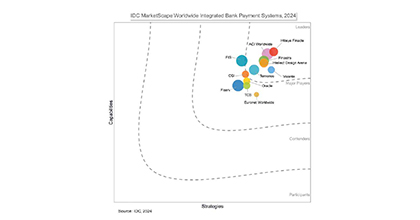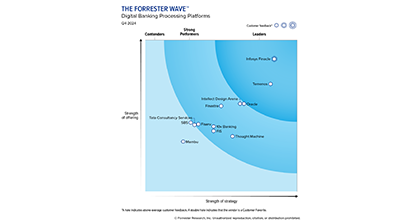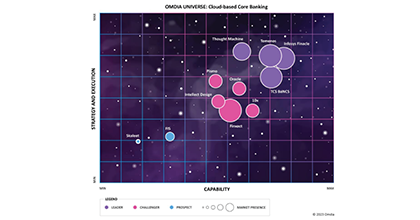-
![]() Quantum Computing: As the Future Awaits, The Strides Are DefinitiveQuantum computing is no longer confined to theory or the edges of experimental science - it is rapidly advancing toward practical impact.Read More
Quantum Computing: As the Future Awaits, The Strides Are DefinitiveQuantum computing is no longer confined to theory or the edges of experimental science - it is rapidly advancing toward practical impact.Read More -
![IDC IDC]() IDC MarketScape: Worldwide Integrated Bank PaymentFinacle Payments is an enterprise payments services system that manages end-to-end payments across instrument types, payment schemes, transaction types, customeRead More
IDC MarketScape: Worldwide Integrated Bank PaymentFinacle Payments is an enterprise payments services system that manages end-to-end payments across instrument types, payment schemes, transaction types, customeRead More -
![]() Supply Chain FinanceToday, as businesses seek to make their ecosystems more resilient, Supply Chain Finance (SCF) has emerged as a powerful lever for banks and financial institutions to support clients, while unlocking new revenue streams.Read More
Supply Chain FinanceToday, as businesses seek to make their ecosystems more resilient, Supply Chain Finance (SCF) has emerged as a powerful lever for banks and financial institutions to support clients, while unlocking new revenue streams.Read More
-
![]() The Future of Core Banking: Business and Technology EvolutionOur point of view paper, “The Future of Core Banking: Business and Technology Evolution”, serves as a candid and forward-looking benchmark of your institution’s readiness—and a strategic playbook for core modernization.Read More
The Future of Core Banking: Business and Technology EvolutionOur point of view paper, “The Future of Core Banking: Business and Technology Evolution”, serves as a candid and forward-looking benchmark of your institution’s readiness—and a strategic playbook for core modernization.Read More -
![The Forrester Wave The Forrester Wave]() Forrester Wave Digital Banking, Q4 2024Finacle is best suited for large retail, SMB, and corporate banks who seek a modern, comprehensive, innovative platform with superior support.Read More
Forrester Wave Digital Banking, Q4 2024Finacle is best suited for large retail, SMB, and corporate banks who seek a modern, comprehensive, innovative platform with superior support.Read More -
![]() Driving Comprehensive Revenue ManagementDiscover why revenue management must evolve into a comprehensive, strategic capability. Decode a blueprint to overcome challenges and unlock sustainable monetization.Read More
Driving Comprehensive Revenue ManagementDiscover why revenue management must evolve into a comprehensive, strategic capability. Decode a blueprint to overcome challenges and unlock sustainable monetization.Read More
-
![]() Shaping Banking’s Next: Banking Technology Trends for 2025 and BeyondThe banking industry has been balancing disruption and opportunity for several years now, and the pace of change shows no signs of slowing as we move into 2025 and beyond.Read More
Shaping Banking’s Next: Banking Technology Trends for 2025 and BeyondThe banking industry has been balancing disruption and opportunity for several years now, and the pace of change shows no signs of slowing as we move into 2025 and beyond.Read More -
![]() Virtual Accounts 2.0: Surpass Conventional Cash Management and Unlock Next-Gen PossibilitiesVirtual Account Management was a groundbreaking shift in the banking landscape, revolutionising use cases like cash concentration, pooling, centralised treasury management, and in-house banking (POBO, ROBO, COBO)Read More
Virtual Accounts 2.0: Surpass Conventional Cash Management and Unlock Next-Gen PossibilitiesVirtual Account Management was a groundbreaking shift in the banking landscape, revolutionising use cases like cash concentration, pooling, centralised treasury management, and in-house banking (POBO, ROBO, COBO)Read More -
![]() Unlocking Hybrid CloudAs banks push forward with their digital transformation agenda, cloud serves as a pivotal enabler. Each bank, at varying stages of adoption, crafts its unique path, dictated by context, regulations, and risk appetite.Read More
Unlocking Hybrid CloudAs banks push forward with their digital transformation agenda, cloud serves as a pivotal enabler. Each bank, at varying stages of adoption, crafts its unique path, dictated by context, regulations, and risk appetite.Read More
-
![]() Banking on CloudThis report from Infosys Finacle delves into the need for accelerating cloud adoption, highlights the current state of the industry, and puts forth key recommenRead More
Banking on CloudThis report from Infosys Finacle delves into the need for accelerating cloud adoption, highlights the current state of the industry, and puts forth key recommenRead More -
![]() Omdia Universe | Cloud-based Core BankingIn the report, Omdia highlights the following key capabilities of leading cloud-based core banking providers:Read more
Omdia Universe | Cloud-based Core BankingIn the report, Omdia highlights the following key capabilities of leading cloud-based core banking providers:Read more
-
![]() Emirates NBDEmirates NBD consolidates its operations on a single version for scalability, agility, and standardization.Read More
Emirates NBDEmirates NBD consolidates its operations on a single version for scalability, agility, and standardization.Read More -
![]() A Global Top 5 BankDiscover how a global top 5 bank headquartered in the US accelerated payments transformation.Read More
A Global Top 5 BankDiscover how a global top 5 bank headquartered in the US accelerated payments transformation.Read More -
![]() Union Bank of IndiaUnion Bank of India launches Union Virtual Connect (UVConn) by leveraging WhatsApp to provide customers personalized banking services.Read More
Union Bank of IndiaUnion Bank of India launches Union Virtual Connect (UVConn) by leveraging WhatsApp to provide customers personalized banking services.Read More

Building a Culture of Analytics for All
Blogs
Knowingly or unknowingly, we all do analysis and decision making in our daily lives. It could be deciding whether to hit the gym, which doctor to go to, which school to put your kid in and even for that matter whether to reward a bonus to your maid or not. The only difference when it comes to corporate life, we somehow are trained into the habit of taking instructions and following the same.
Corporates are readily equipped to build analytics driven products, but to build an analytics-driven culture is not easy. Culture cannot be brought in from outside, it has to evolve from within. It has to be lived. We can start by questioning ourselves – is it there at my workplace? Are we enough curious enough to understand the what and the why of what we do on a daily basis at our workplace? No points for guessing. Yeah we are still not there.
Internal clients – “Ohhoh… I am always left out”
To put it in simple words, analytics means structured problem solving. Not many at workplace acknowledge in the first place that there is a problem at hand to think and solve. Most workplaces understand and are geared up to provide analytics solutions to their external clients. But what about internal clients and where does analytics fit in? Will try to put across by way of examples – Do we use decision models to decide which clients to pursue? What is the expected client traction for the current product roadmap? Was analytics used to determine which category of opportunities resulted in best results? Can I prescribe what product features are required if I expect a % of turn around? This is where leaders can make a difference and educate their internal teams to identify the problem statement and inculcate the habit of applying analytics in the daily jobs being done. Walk the talk is the mantra.
“Curious for data and knowledge… I might just burn my fingers”
Once we cross the first hurdle to bring the team on common line to identify the purpose of analytics at workplace, the next road block is when teams have to overcome their own perceptions and fears. Some f the common myths that teams hold are – “The data is not there “, “It’s a lot of junk data and results may not be accurate”, “I will lose the power if I share the data”, “it’s too time-consuming, and the cost required to analyze is way too much”. A lot of us ask the right questions but how many of us try to get the right answers? I think the best bet here is to simplify the problem statement and encourage all to find answers. Organizations must transparently reward people to encourage sharing and analyzing data. Once a few rewards are won and the process is in place, the skeptics start losing ground.
“Old ways are always the best ways… why are u disturbing the set up!!!”
Then the next hurdle, once everything is in place, is to implement the outcomes of analytics and to get the team to adhere to new processes. That’s when the trouble doubles up. At times mix and match of teams and cross-skilling can deliver surprising results in overcoming resistance. The changes may not necessarily be only in numbers or end results, but also in identifying training needs, staffing needs etc. Here team leaders and managers need to support the team by giving them the training required and should give a quick view into the results as well.
“Trust Anchor”
The quality of data driven decisions in itself acts as a trust anchor for everyone. Decision making process does not always have to be behind closed doors. It can be more transparent and should involve employees at all levels who embrace analytics. For example, base level employees can contribute to data collection and can apply the tools to come up with the diagnostics for the higher-ups to view. A sense of ownership and a view into the entire decision making process results in increased employee engagement. A data-driven culture evolves and matures through such engaged employees.


Download the Latest Report
The Future of Core Banking: Business and Technology Evolution


©2025 -Edgeverve Systems Limited | All rights reserved

















